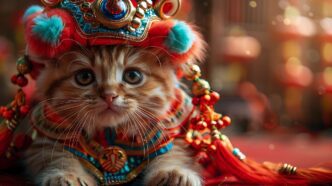In the intricate tapestry of Vedic Astrology, few planetary combinations evoke as much awe, fear, and fascination as the Kala Sarpa Yoga. This powerful configuration, whose name translates to the “Serpent of Time,” occurs when all seven classical planets—the Sun, Moon, Mars, Mercury, Jupiter, Venus, and Saturn—are hemmed in between the karmic nodes of Rahu (the serpent’s head) and Ketu (the serpent’s tail). For individuals born with this yoga in their birth chart, life often feels like a fated journey marked by intense, unforeseen challenges and extraordinary potential, compelling them to confront their deepest karmic lessons head-on. Understanding this yoga is crucial, as it defines a life path where struggles can lead to profound spiritual growth and remarkable, albeit hard-won, success.
What is Kala Sarpa Yoga?
At its core, Kala Sarpa Yoga is a specific alignment within a natal chart. Imagine the zodiac as a 360-degree circle. Rahu and Ketu always sit exactly 180 degrees opposite each other, forming a powerful axis. When all other planets fall into the 180-degree arc on one side of this axis, the yoga is formed. The empty half of the chart signifies a vacuum or a profound area of unfulfilled desire, which the individual spends their life trying to fill.
The name itself is deeply symbolic. “Kala” means time, and “Sarpa” means serpent. Rahu and Ketu are depicted as a celestial serpent, with Rahu being the insatiably ambitious head and Ketu being the detached, spiritual tail. When the planets are caught within their grasp, it is believed that the serpent’s karmic grip dictates the flow of the native’s life, creating a sense of destiny that is both restrictive and potent.
It is important to clarify that this is a yoga (a planetary combination) and not inherently a dosha (a flaw or affliction). While its effects are often challenging, it is not a curse. Rather, it is an indicator of a significant and concentrated karmic path that requires immense effort to navigate.
Anuloma vs. Viloma: The Direction of Karma
The intensity and nature of the Kala Sarpa Yoga can vary depending on the direction the planets are moving in relation to the nodes. This gives rise to two primary classifications.
Anuloma Kala Sarpa Yoga, or the ascending type, occurs when the planets are moving from Ketu towards Rahu. This is generally considered the slightly less arduous of the two. It suggests a life path that moves from past-life detachment and loss (Ketu) towards future-oriented ambition and material desire (Rahu). Individuals may face significant struggles in the first half of life but can achieve great success later on as they learn to harness Rahu’s energy.
Viloma Kala Sarpa Yoga, the descending type, is formed when the planets are moving from Rahu towards Ketu. This path can be more psychologically complex. The individual’s soul journey is one of moving away from worldly obsession (Rahu) towards spiritual liberation and non-attachment (Ketu). This can create immense internal conflict, as worldly ambitions are constantly thwarted by a pull towards introspection and letting go, often leading to sudden reversals of fortune, especially in the latter half of life.
The Life Experience of Kala Sarpa Yoga
Individuals with this yoga often report a distinct pattern of experiences. Life is rarely a smooth, upward trajectory. Instead, it is characterized by sudden, dramatic rises and equally sudden falls. They may achieve great heights only to have it all taken away, forcing them to rebuild from scratch.
A pervasive feeling of being “stuck” or held back by unseen forces is common. Despite talent and hard work, success can be frustratingly delayed. Obstacles appear out of nowhere, and the native may feel that they are not fully in control of their own destiny, as if they are a pawn in a larger cosmic game.
This yoga funnels the entirety of a person’s life force through the Rahu-Ketu axis. Consequently, the houses where these nodes are placed become the primary battlefield of life. All life events, struggles, and triumphs are interpreted through the lens of this axis, making its themes overwhelmingly dominant.
However, this intense focus is also the source of its power. Kala Sarpa Yoga can produce individuals of extraordinary genius, talent, and fame. Because their energy is not scattered, they can develop a laser-like focus that, when correctly channeled, leads to unprecedented achievements. Many world leaders, pioneering scientists, and celebrated artists have had this yoga in their charts.
The 12 Varieties of Kala Sarpa Yoga
The specific life themes are determined by the houses occupied by Rahu and Ketu. There are 12 primary combinations, each with a unique name and focus.
1. Anant Kala Sarpa Yoga (1st/7th House Axis)
With Rahu in the 1st House (self) and Ketu in the 7th (partnership), the primary struggle is between self-identity and relationships. These individuals may struggle with self-esteem, have a constant need to prove themselves, and face significant challenges in marriage and business partnerships.
2. Kulik Kala Sarpa Yoga (2nd/8th House Axis)
Rahu in the 2nd House (wealth, family) and Ketu in the 8th (sudden events, longevity) creates turbulence around finances and family life. There can be issues with speech, struggles to accumulate wealth, and a life marked by sudden, transformative events and interest in the occult.
3. Vasuki Kala Sarpa Yoga (3rd/9th House Axis)
When Rahu is in the 3rd House (courage, siblings) and Ketu is in the 9th (faith, gurus), the conflict is between self-effort and destiny. The native may have strained relationships with siblings and neighbors while questioning higher beliefs, teachers, and their own fortune.
4. Shankhapal Kala Sarpa Yoga (4th/10th House Axis)
This yoga, with Rahu in the 4th House (home, mother) and Ketu in the 10th (career, status), creates a classic work-life imbalance. There is deep unrest at home and with the mother, while the career path is unstable, marked by unexpected shifts in status and public image.
5. Padma Kala Sarpa Yoga (5th/11th House Axis)
Rahu in the 5th House (creativity, children) and Ketu in the 11th (gains, networks) brings challenges related to education, children, and speculation. Friendships and social networks may feel unsupportive, and achieving large-scale gains can be a lifelong struggle.
6. Mahapadma Kala Sarpa Yoga (6th/12th House Axis)
With Rahu in the 6th House (enemies, health) and Ketu in the 12th (loss, spirituality), life becomes a battle against debts, diseases, and hidden enemies. There is a strong pull towards spiritual isolation, foreign lands, and hidden matters, often at the expense of practical, daily life.
7. Takshak Kala Sarpa Yoga (7th/1st House Axis)
The reverse of Anant, this yoga places Rahu in the 7th House and Ketu in the 1st. The obsession is with partnerships and public image, often leading to a loss of self. Marital life can be extremely tumultuous, and the native’s identity becomes defined by their relationships.
8. Karkotak Kala Sarpa Yoga (8th/2nd House Axis)
Rahu in the 8th House and Ketu in the 2nd creates a deep fascination with mysteries, inheritance, and other people’s money. This can lead to sudden financial gains or losses, while simultaneously creating detachment from one’s own family and accumulated wealth.
9. Shankhachood Kala Sarpa Yoga (9th/3rd House Axis)
With Rahu in the 9th House and Ketu in the 3rd, there is an obsession with philosophy, religion, and long-distance travel. The native may become a zealot or, conversely, face scandals related to their beliefs, while lacking the courage and initiative to act on their convictions.
10. Ghatak Kala Sarpa Yoga (10th/4th House Axis)
Rahu in the 10th House and Ketu in the 4th creates an all-consuming drive for career success and status. This ambition often comes at the cost of domestic peace and emotional well-being, leading to a feeling of being emotionally hollow despite public success.
11. Vishdhar Kala Sarpa Yoga (11th/5th House Axis)
Rahu in the 11th House and Ketu in the 5th creates an insatiable desire for large gains, powerful friends, and fulfilling ambitions. However, this is often undermined by problems with children, failed romantic affairs, and poor speculative judgment.
12. Sheshnag Kala Sarpa Yoga (12th/6th House Axis)
The final yoga places Rahu in the 12th House and Ketu in the 6th. The focus is on foreign lands, hidden matters, and spiritual liberation, but this can lead to legal troubles, secret enemies, and health issues. There is a constant tension between service and escapism.
Breaking the Bind: Nullification and Remedies
The full impact of Kala Sarpa Yoga is a subject of astrological debate. Many scholars argue that if even one planet escapes the axis, the yoga is technically “broken” or nullified. While its influence may still be felt partially, the extreme restriction is lifted.
Furthermore, the presence of a strong benefic planet like Jupiter aspecting the Lagna (Ascendant) or the Moon can provide a powerful protective shield. A strong Lagna lord itself gives the native the resilience to overcome the fated challenges presented by the yoga.
For those seeking to mitigate its effects, Vedic tradition offers several remedies:
- Mantra Chanting: Regularly chanting the Beej (seed) mantras for Rahu and Ketu can help balance their energies. The Maha Mrityunjaya Mantra, dedicated to Lord Shiva, is considered a universal panacea for astrological afflictions.
- Worship: Devotion to Lord Shiva, who wears a serpent as an ornament, is highly recommended. Worshipping Lord Ganesha, the remover of obstacles, is also extremely beneficial.
- Acts of Service: Performing selfless service (seva) helps to resolve difficult karma. For Rahu, this can involve helping those with leprosy or skin diseases. For Ketu, feeding and caring for stray dogs is a classic remedy.
- Specific Pujas: A specialized “Kala Sarpa Yoga Shanti Puja” can be performed by qualified priests at holy sites like Trimbakeshwar in Nashik, India, which is specifically dedicated to this purpose.
Ultimately, Kala Sarpa Yoga is not a life sentence of misery but a profound spiritual calling. It forges character in the crucible of adversity, creating individuals of immense strength, resilience, and focus. It signifies a life where the battle between worldly desire and spiritual liberation is played out on a grand stage. By understanding its mechanics and embracing its lessons, one can navigate the serpent’s path not as a victim of fate, but as the hero of their own epic journey.








